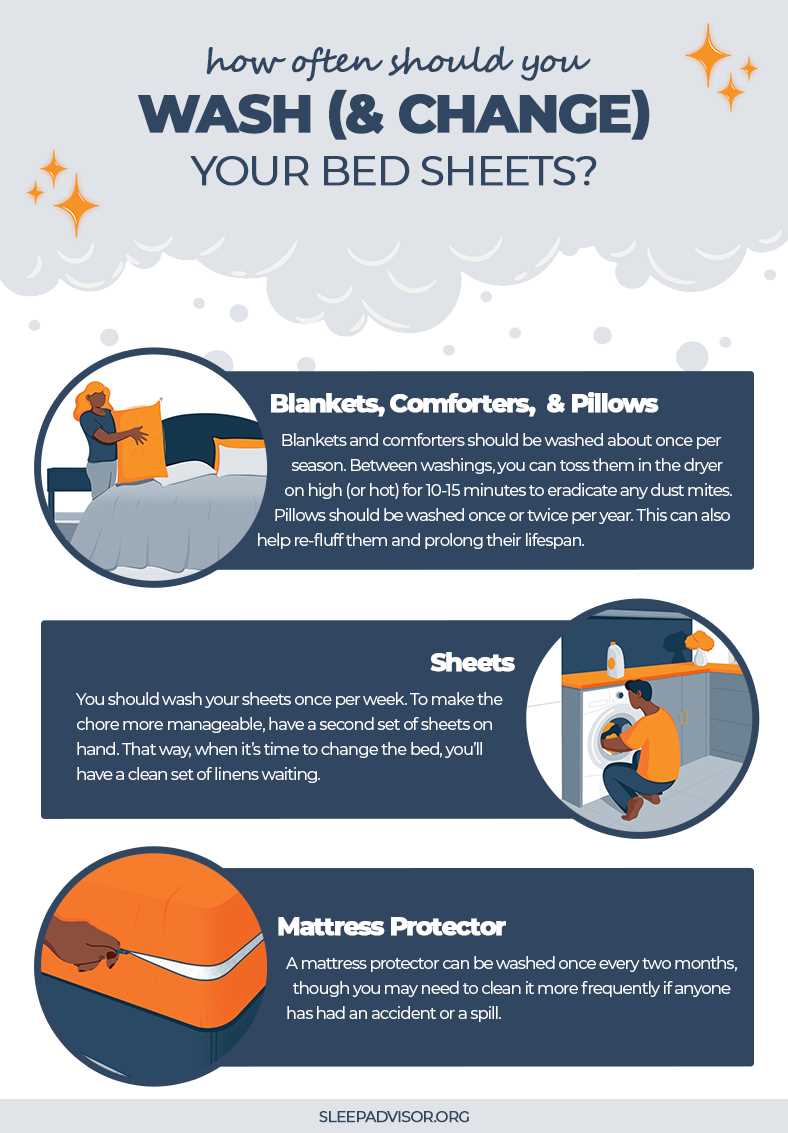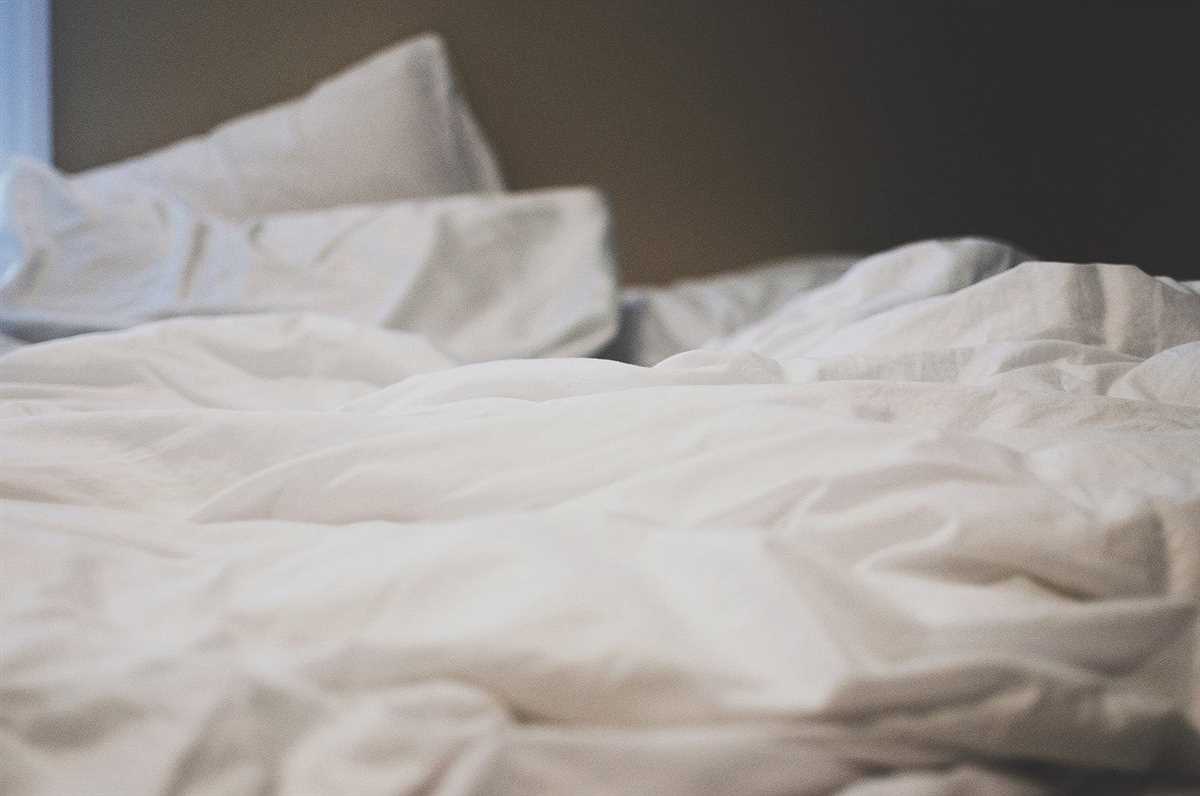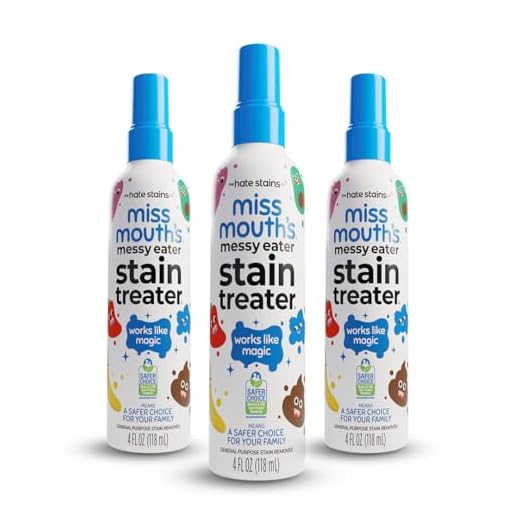




Keeping your bedding clean and fresh is essential for a good night’s sleep and maintaining overall hygiene. But have you ever wondered what temperature you should be washing your bedding at? Well, we’ve got you covered.
Experts recommend that bedding should be washed at a temperature of at least 60 degrees Celsius (140 degrees Fahrenheit) in order to kill any bacteria, dust mites, and allergens that may be lurking in your sheets, pillowcases, and duvet covers. This high temperature ensures a thorough clean and helps to eliminate the risk of allergies and respiratory issues.
However, it’s important to note that not all bedding materials can withstand high temperatures. Delicate fabrics such as silk, satin, or wool may require a gentler wash at lower temperatures to prevent damage. Always check the care labels on your bedding for specific temperature recommendations.
In addition to temperature, using a good quality detergent and a hot wash cycle can help to remove stains, odors, and any build-up of dirt or sweat. Don’t forget to separate your whites from your colors to avoid any color bleeding, and consider adding a fabric softener or vinegar for extra freshness.
A regular washing routine, combined with the right temperature, can help to keep your bedding clean, fresh, and free from allergens. So, next time you’re doing your laundry, make sure to give your bedding the attention it deserves!
What’s the Ideal Temperature to Wash Your Bedding? A Comprehensive Guide

Introduction
When it comes to washing your bedding, finding the ideal temperature can be a tricky task. Different types of bedding materials and stains require different water temperatures to effectively remove dirt and bacteria. In this comprehensive guide, we will explore the ideal temperature to wash various types of bedding to ensure your linens are clean and fresh.
Types of Bedding

Before discussing the ideal washing temperatures, let’s first understand the different types of bedding materials:
- Cotton: Cotton bedding is a popular choice due to its breathability and durability.
- Silk: Silk bedding is known for its luxurious feel and delicate nature.
- Polyester: Polyester bedding is known for its wrinkle resistance and easy care.
- Down: Down bedding is filled with feathers and provides exceptional warmth and comfort.
Ideal Washing Temperatures
The ideal temperature for washing your bedding depends on the material and the level of cleanliness required. Here are some general guidelines:
| Bedding Type | Ideal Washing Temperature |
|---|---|
| Cotton | Warm or hot water (between 40°C and 60°C) |
| Silk | Cool or cold water (below 30°C) |
| Polyester | Cool or warm water (below 40°C) |
| Down | Cool or warm water (below 40°C) |
Tips for Washing Bedding
Here are some additional tips to keep in mind when washing your bedding:
- Check the care instructions on your bedding for specific temperature recommendations.
- Use a gentle detergent to avoid damaging delicate materials.
- Consider using a laundry booster or stain remover for stubborn stains.
- Separate light and dark colored bedding to prevent color bleeding.
- Occasionally wash your bedding on higher temperatures to kill bacteria and dust mites.
- Hang or line dry your bedding whenever possible to preserve the fabric’s quality.
Conclusion
By following the suggested washing temperatures for different types of bedding, you can ensure that your linens are clean, fresh, and long-lasting. Remember to always read the care instructions on your bedding and use appropriate detergents to maintain the quality of your bedding for years to come.
Understanding the Importance of Washing Bedding at the Right Temperature
Washing bedding at the right temperature is crucial for maintaining cleanliness and hygiene. Different temperatures have varying effects on different types of beddings, and understanding these effects can help prolong the lifespan of your bedding while keeping it free from dirt and allergens.
1. Hot water kills germs and dust mites
Washing your bedding in hot water, typically above 130°F (54°C), helps kill bacteria, germs, and dust mites that may be lurking in your sheets and pillowcases. This is particularly beneficial for people with allergies or sensitivities.
2. Cold water preserves colors and delicate fabrics
Certain types of bedding, such as silk or delicate fabrics, can be damaged by hot water. Washing them in cold water helps preserve their colors and prevents shrinkage. Cold water can also be effective for removing stains, as hot water can set stains and make them more difficult to remove.
3. Warm water is a gentle option for most beddings
For most beddings, including cotton, polyester, and blends, washing them in warm water, around 90°F (32°C) to 110°F (43°C), is a safe and effective option. Warm water can help remove dirt, sweat, and oils, while still being gentle enough to maintain the quality of the fabric.
4. Be cautious with heavily soiled bedding
If your bedding is heavily soiled or stained, it may require a higher temperature wash. However, always check the care labels on your bedding for specific washing instructions, as some materials may be sensitive to high temperatures and need to be washed at a lower temperature or with special care.
5. Consider using a laundry sanitizer
In addition to temperature, you may also consider using a laundry sanitizer to further enhance the cleanliness of your bedding. These sanitizers can be added to your washing machine during the rinse cycle and help eliminate bacteria, odors, and allergens.
Conclusion
Understanding the importance of washing bedding at the right temperature is essential for maintaining cleanliness and hygiene. Hot water helps kill germs and dust mites, while cold water preserves colors and delicate fabrics. Warm water is a gentle option for most bedding materials. Always check the care labels and be cautious with heavily soiled bedding. Consider using a laundry sanitizer for added cleanliness. By following these guidelines, you can ensure your bedding stays fresh, comfortable, and allergen-free for a longer period of time.
Expert Advice on Choosing the Right Temperature for Your Bedding
Choosing the right temperature to wash your bedding is essential for maintaining its quality, hygiene, and longevity. Here is some expert advice on how to decide on the best temperature for washing your bedding.
Consider the Fabric

The first step in determining the right temperature is to consider the fabric of your bedding. Different fabrics require different care and washing temperatures.
- Cotton: Cotton bedding can be washed at higher temperatures, usually between 40°C (104°F) and 60°C (140°F). This helps to remove stains and kill bacteria effectively.
- Silk: Silk bedding is more delicate and should be washed at lower temperatures, such as 30°C (86°F) to 40°C (104°F). Higher temperatures can damage the fabric.
- Microfiber: Microfiber bedding can be washed at lower temperatures, typically around 30°C (86°F). Higher temperatures may cause the fibers to become damaged or lose their softness.
Consider Allergies and Sensitivities
If you or your family members have allergies or sensitivities, it’s important to wash your bedding at higher temperatures to kill allergens and dust mites.
- Pollen Allergies: If you struggle with pollen allergies, washing your bedding at a higher temperature (around 60°C or 140°F) can help to remove pollen particles effectively.
- Dust Mite Allergies: Dust mites are a common cause of allergies. Washing bedding at temperatures above 60°C (140°F) can kill dust mites and their eggs, reducing allergic reactions.
Balance Between Hygiene and Conservation
While higher temperatures can provide better hygiene, they also consume more energy and may cause faster wear and tear on your bedding.
- Normal Soil: For bedding that is not heavily soiled, a temperature of 30°C (86°F) to 40°C (104°F) can effectively clean and disinfect without excessive energy consumption.
- Heavy Soil and Stains: If your bedding has heavy soil or stains, consider washing at higher temperatures (around 60°C or 140°F) for better stain removal and hygiene.
Additional Tips
Here are some additional tips to keep in mind when washing your bedding:
- Always check the care label instructions on your bedding for specific temperature recommendations.
- Consider using a gentle cycle or a special bedding cycle to prevent excessive agitation and protect the fabric.
- Use a mild detergent that is suitable for your specific bedding fabric.
- Avoid overloading the washing machine to ensure that your bedding can move freely during the wash cycle.
- After washing, hang or lay your bedding flat to dry to avoid shrinkage or damage from high heat.
By considering the fabric, allergies and sensitivities, and balancing hygiene and conservation, you can choose the right temperature to wash your bedding and keep it clean, fresh, and long-lasting.
Factors to Consider When Deciding on the Temperature
When it comes to washing bedding, there are several factors to consider when deciding on the temperature to use. Here are some important factors that can help guide your decision:
- Fabric type: Different types of bedding materials require different washing temperatures. It’s important to consult the care label on your bedding to determine the recommended temperature. For example, some delicate fabrics may require a cold water wash to prevent damage, while others can tolerate higher temperatures.
- Stain type: The type of stain on your bedding can also affect the temperature you choose. For general cleaning and regular maintenance, a warm water wash is often sufficient. However, for stubborn stains or bacteria, a hot water wash may be necessary to effectively remove the dirt and germs.
- Allergies: If you or someone in your household has allergies or sensitivities, washing bedding in hot water can help remove allergens such as dust mites. Hot water (130°F or above) can effectively kill dust mites and other microscopic organisms that can trigger allergies.
- Energy efficiency: Washing bedding in hot water requires more energy compared to using cold or warm water. If you are concerned about reducing your energy consumption and utility bills, washing in cold water or using the warm setting can be more energy-efficient options.
- Fabric color: Certain colors can bleed or fade when exposed to hot water or harsh detergents. If you have brightly colored or printed bedding, it’s generally safer to wash it in cold water to prevent color loss or bleeding.
Ultimately, the temperature at which you should wash your bedding depends on a combination of these factors. It’s essential to check the care label, consider the fabric type, stain type, allergies, energy efficiency, and fabric color before making a decision. By taking these factors into account, you can ensure that your bedding is clean, fresh, and well-maintained.
Tips for Washing Bedding at the Appropriate Temperature
When it comes to washing your bedding, the temperature at which you wash it can have a significant impact on its cleanliness and longevity. Here are some tips to help you wash your bedding at the appropriate temperature:
1. Read the care label
Before washing your bedding, check the care label for any specific temperature recommendations. Different fabrics and materials may require different washing temperatures to maintain their quality.
2. Hot water for white and heavily soiled bedding
If your bedding is white or heavily soiled, washing it in hot water, typically around 60°C (140°F), can help remove stains, dirt, and bacteria effectively. Hot water is known to kill dust mites as well.
3. Warm water for colored bedding
Colored bedding should be washed in warm water, typically around 40°C (104°F). Warm water can effectively remove stains and dirt, while also preserving the color of your bedding.
4. Cool water for delicate fabrics
If your bedding is made from delicate fabrics such as silk or satin, it’s best to wash them in cool water, typically around 30°C (86°F). Cool water helps to prevent damage and shrinking of delicate fabrics.
5. Use a gentle cycle
Regardless of the temperature, it is recommended to use a gentle cycle when washing your bedding. This can help protect the fabric and prevent excessive wear and tear.
6. Avoid overloading the washing machine
To ensure that your bedding gets properly cleaned, avoid overloading the washing machine. Overcrowding can prevent the bedding from moving freely and getting thoroughly washed.
7. Consider using a laundry booster
If your bedding has stubborn stains or odors, consider using a laundry booster or stain remover. These products can help enhance the cleaning power of your detergent.
8. Regularly clean your washing machine
To maintain the cleanliness of your bedding, it is important to regularly clean your washing machine. This helps remove any buildup of dirt, detergent residue, and bacteria that can transfer to your bedding.
By following these tips and washing your bedding at the appropriate temperature, you can ensure that your bedding stays clean, fresh, and durable for a longer period of time.
Common Myths and Misconceptions About Washing Bedding Temperature
- Myth: Hot water is always better for washing bedding.
- Myth: Cold water doesn’t clean as effectively as hot water.
- Myth: Washing bedding on a high temperature setting is necessary to remove stains.
- Myth: All bedding should be washed in the same temperature.
While hot water can help kill bacteria and dust mites, it is not always necessary for washing bedding. In fact, using hot water can sometimes cause damage to certain fabrics or fade colors. It is important to read the care instructions on your bedding to determine the best temperature to use.
Contrary to popular belief, cold water can actually effectively clean your bedding. Many modern detergents are designed to work well in cold water, and washing with cold water can help prevent shrinking or fading of fabrics. If you are concerned about bacteria or allergens, you can always use a laundry sanitizer or add a small amount of bleach to your cold water wash.
While higher temperature settings can help remove tough stains, they are not always necessary for regular stain removal. Pre-treating stains with a stain remover or soaking the bedding in a detergent solution before washing can often be just as effective as using a high temperature setting. It is important to test the stain remover on a small, inconspicuous area of the bedding first to ensure it doesn’t damage the fabric.
Different types of bedding may require different temperature settings. For example, delicate fabrics like silk or satin may require a lower temperature setting to avoid damage. It is important to read the care instructions on your bedding and adjust the temperature accordingly.
Overall, it’s important to consider the specific care instructions for your bedding and adjust the temperature settings accordingly. While hot water can be effective for killing bacteria and dust mites, it is not always necessary and can sometimes cause damage to fabrics. Cold water can be just as effective for cleaning and can help prevent shrinking or fading of fabrics. Pre-treating stains and using the appropriate temperature settings for different types of bedding can also help maintain the quality and prolong the lifespan of your bedding.
FAQ
What temperature should I wash my bedding at to kill bacteria and germs?
Experts recommend washing bedding at a temperature of at least 60°C to effectively kill bacteria and germs.
Is it safe to wash bedding at high temperatures?
Yes, it is generally safe to wash bedding at high temperatures. Most bedding materials can withstand higher temperatures without significant damage.
What temperature should I wash my bedding if it is stained?
If your bedding is stained, it is recommended to wash it at a higher temperature, such as 40-60°C, to remove the stains effectively.
Can I wash my bedding at a lower temperature to save energy?
Washing bedding at lower temperatures, such as 30°C, can help save energy. However, it may not eliminate bacteria and germs as effectively as washing at higher temperatures.














